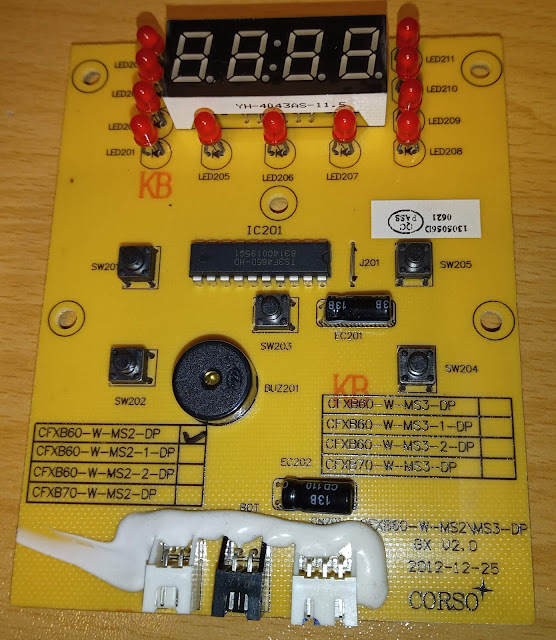Repair of multi-cooker control board CFXB60-W-MS2-DP CFXB60-W-MS2\MS3-DP GX V2.0 CORSO with IC TS3F465D-HD from Sapir SP-1985-A5
Markings on the PCB are:
CFXB60-W-MS2-DP
CFXB60-W-MS2\MS3-DP
GX V2.0
2012-12-25
CORSO
Multicookers with this board are sold under brands Sapir and Redmond (and possibly other brands).
The symptom is that before the program finishes it turns off.
First, I repaired it by re-soldering most interesting of the solder joints. Or I tough that I repaired it.
It worked for some time.
But it's now showing the same symptom. It improved after I made a makeshift thermal shield to protect the control board from the heat. Now it's turning off but after more time. (It's from simple observation, I did not made a systematic experiments to measure the time/temperature for turning off).
When it turns off the display is off or is blinking strangely. After I unplug the power cord and plug it again the blinking is not present.
After I wait to cool down it works again.
I soldered a LED (with resistor in series) to the point where the IC is powered to see if the IC is getting power. It emits light, therefore there is a power to the IC. (I first thought that it's the thermal fuse, but it's not. Because there is a supply voltage to the IC).
The capacitor filtering the supply voltage for the IC is ok, I changed it just in case, there is no difference.
In the disassembled state, I did a stress test - I heated the integrated circuit with hot air 100 degrees. There was no change from the warm-up. With the hot air, I mainly heated the integrated circuit, not the surrounding elements.
However, after a while it unexpectedly stopped working. After turning on/off and tapping it worked again, then stopped working again.
Thus, I falsified the hypothesis that the problem is the overheating of the integrated circuit. If the hypothesis was true it would stop working as soon as I warmed up the IC, not after it started to cool.
I decided to make bypasses - I connected the +PWR pin of the IC directly to the filtering capacitor, the GND pin of the IC I connected directly to the connector. I resoldered the more important joints and the rest of the joints that I had not resoldered in the previous repair attempts.
By measuring the voltage on the +PWR of the integrated circuit with a multimeter (when it works and when it does not work) I found that a low voltage is being applied to the integrated circuit and this is the cause of the problem. Therefore, I made a mistake by putting an LED to monitor the supply voltage of the integrated circuit instead of using a multimeter (by eye, by the light of the LED, there is no way to distinguish the normal supply voltage from the reduced one).
In the previous checks, I did not catch this problem because I measured the voltage supplied to the board - it is fine and does not change. The voltage after the silicon diode D202 changes (only when the unit is in an broken state, which was only observed when it was not disassembled). Since the supply is slightly above 5V the diode serves to step it down to a suitable volgate (around 5V).
The diode increases its resistance and this results in a reduced supply voltage to the +PWR pin of the IC.
I replaced the problematic diode with a 1N5399, with which I hope the multicooker will work normally. This diode can withstand an amp and a half, which is much more than the current expected to flow through it.
I am using a replacement pot made from stainless steel. The product number on AliExpress is 1005004187413386, the model is "5L 23.7xH14.5cm".
The markings on the pot (for the fluid levels) are completely wrong. But the size matches.
I prefer to use the 304 stainless steel instead of the original non-stick pot. I don't believe the non-stick coating is safe as the 340 stainless steel.









Comments
Post a Comment